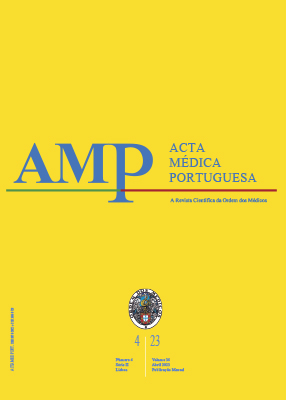Consensus Guidelines for the Management of Abnormal Cervical Cancer Screening Tests by the SPCPTGI
DOI:
https://doi.org/10.20344/amp.18776Keywords:
Colposcopy, Human Papillomavirus, Screening, Squamous Intraepithelial Lesions, Uterine Cervical NeoplasmsAbstract
Cervical cancer is one of the most common types of cancer in women. Cervical cancer screening is needed for the detection and treatment of cervical neoplastic lesions that can evolve to neoplasia and to reduce the incidence of cervical cancer. Recently, changes were made to increase the efficiency of the screening process such as employing the human papilloma virus detection test as the gold standard for cervical cancer screening and acknowledging the importance of adapting clinical practice to consider the risk of developing this neoplasia. Considering this paradigm shift, new clinical practice guidelines are now needed. For this purpose, a group of experts analyzed and discussed the most recent literature, defining recommendations and proposing clinical practice guidelines that focus on risk stratification, diagnostic evaluation, and on the therapeutical approach and follow-up of women with altered screening results. The aim of this article is to guide clinical practice regarding actions to take in face of altered results of cervical cancer screening and, consequently, to improve the secondary prevention of this condition.
Downloads
References
Sung H, Ferlay J, Siegel RL, Laversanne M, Soerjomataram I, Jemal A, et al. Global Cancer Statistics 2020: GLOBOCAN Estimates of Incidence and Mortality Worldwide for 36 Cancers in 185 Countries. CA Cancer J Clin. 2021;71:209-249. DOI: https://doi.org/10.3322/caac.21660
International Agency for research on Cancer - Global Cancer Observatory 2020. Estimated age-standardized incidence rates (World) in 2020, all cancers, both sexes, all ages. Disponível em https://gco.iarc.fr/today/online-analysis-map?v=2020.
World Health Organization. Global strategy to accelerate the elimination of cervical cancer as a public health problem 2020.
Secção Portuguesa de Colposcopia e Patologia do Trato Genital Inferior da Sociedade Portuguesa de Ginecologia (SPCPTGI-SPG). Livro de Consenso Sobre Lesões Intraepiteliais do Colo do Útero, Vulva e Vagina. 2014.
Harbour R, Miller J. A new system for grading recommendations in evidence based guidelines. BMJ. 2001;323:334-336. DOI: https://doi.org/10.1136/bmj.323.7308.334
Perkins RB, Guido RS, Castle PE, Chelmow D, Einstein MH, Garcia F, et al. 2019 ASCCP Risk-Based Management Consensus Guidelines for Abnormal Cervical Cancer Screening Tests and Cancer Precursors. J Low Genit Tract Dis. 2020;24:102-131. DOI: https://doi.org/10.1097/LGT.0000000000000525
Wright TC, Jr., Stoler MH, Behrens CM, Apple R, Derion T, Wright TL. The ATHENA human papillomavirus study: design, methods, and baseline results. Am J Obstet Gynecol. 2012;206:46.e41-46.e11. DOI: https://doi.org/10.1016/j.ajog.2011.07.024
Gage JC, Hanson VW, Abbey K, Dippery S, Gardner S, Kubota J, et al. Number of cervical biopsies and sensitivity of colposcopy. Obstet Gynecol. 2006;108:264-272. DOI: https://doi.org/10.1097/01.AOG.0000220505.18525.85
Song Y, Zhao YQ, Zhang X, Liu XY, Li L, Pan QJ, et al. Random biopsy in colposcopy-negative quadrant is not effective in women with positive colposcopy in practice. Cancer Epidemiol. 2015;39:237-241. DOI: https://doi.org/10.1016/j.canep.2015.01.008
Massad LS, Einstein MH, Huh WK, Katki HA, Kinney WK, Schiffman M, et al. 2012 updated consensus guidelines for the management of abnormal cervical cancer screening tests and cancer precursors. Obstet Gynecol. 2013;121:829-846. DOI: https://doi.org/10.1097/AOG.0b013e3182883a34
Darragh TM, Colgan TJ, Cox JT, Heller DS, Henry MR, Luff RD, et al. The Lower Anogenital Squamous Terminology Standardization Project for HPVAssociated Lesions: background and consensus recommendations from the College of American Pathologists and the American Society for Colposcopyand Cervical Pathology. Arch Pathol Lab Med. 2012;136:1266-1297. DOI: https://doi.org/10.5858/arpa.LGT200570
Massad LS, Einstein MH, Huh WK, Katki HA, Kinney WK, Schiffman M, et al. 2012 updated consensus guidelines for the management of abnormal cervical cancer screening tests and cancer precursors. J Low Genit Tract Dis. 2013;17:S1-s27. DOI: https://doi.org/10.1097/LGT.0b013e318287d329
Partridge EE, Abu-Rustum N, Campos S, Fahey PJ, Greer BE, Lele SM, et al. Cervical cancer screening. J Natl Compr Canc Netw. 2008;6:58-82. DOI: https://doi.org/10.6004/jnccn.2008.0007
Partridge EE, Abu-Rustum NR, Campos SM, Fahey PJ, Farmer M, Garcia RL, et al. Cervical cancer screening. J Natl Compr Canc Netw. 2010;8:1358-1386. DOI: https://doi.org/10.6004/jnccn.2010.0103
ACOG Practice Bulletin No. 99: management of abnormal cervical cytology and histology. Obstet Gynecol. 2008;112:1419-1444. DOI: https://doi.org/10.1097/AOG.0b013e318192497c
Published
How to Cite
Issue
Section
License
Copyright (c) 2023 Acta Médica Portuguesa

This work is licensed under a Creative Commons Attribution-NonCommercial 4.0 International License.
All the articles published in the AMP are open access and comply with the requirements of funding agencies or academic institutions. The AMP is governed by the terms of the Creative Commons ‘Attribution – Non-Commercial Use - (CC-BY-NC)’ license, regarding the use by third parties.
It is the author’s responsibility to obtain approval for the reproduction of figures, tables, etc. from other publications.
Upon acceptance of an article for publication, the authors will be asked to complete the ICMJE “Copyright Liability and Copyright Sharing Statement “(http://www.actamedicaportuguesa.com/info/AMP-NormasPublicacao.pdf) and the “Declaration of Potential Conflicts of Interest” (http:// www.icmje.org/conflicts-of-interest). An e-mail will be sent to the corresponding author to acknowledge receipt of the manuscript.
After publication, the authors are authorised to make their articles available in repositories of their institutions of origin, as long as they always mention where they were published and according to the Creative Commons license.









